Rip Pty Ltd: Income, Deductions & Taxation Law Implications- 2016
VerifiedAdded on 2023/06/11
|9
|2247
|495
Case Study
AI Summary
This case study provides a detailed analysis of Rip Pty Ltd, a funeral service business, under Australian taxation law. It examines the company's income sources, including fees from various payment arrangements and advance payments for future services, to determine assessable income. The analysis applies the principles established in Arthur Murray (NSW) Pty Ltd V FCT (1965) 114 CLR 314. Furthermore, the case study explores potential deductions related to stock in trade and capital expenditures, considering provisions of the Income Tax Assessment Act, 1997, particularly sections 70.10, 8.1, and 100.25. The study also addresses the treatment of dividends and long service leave payments, providing a comprehensive overview of Rip Pty Ltd's tax obligations for the year ending June 2016.
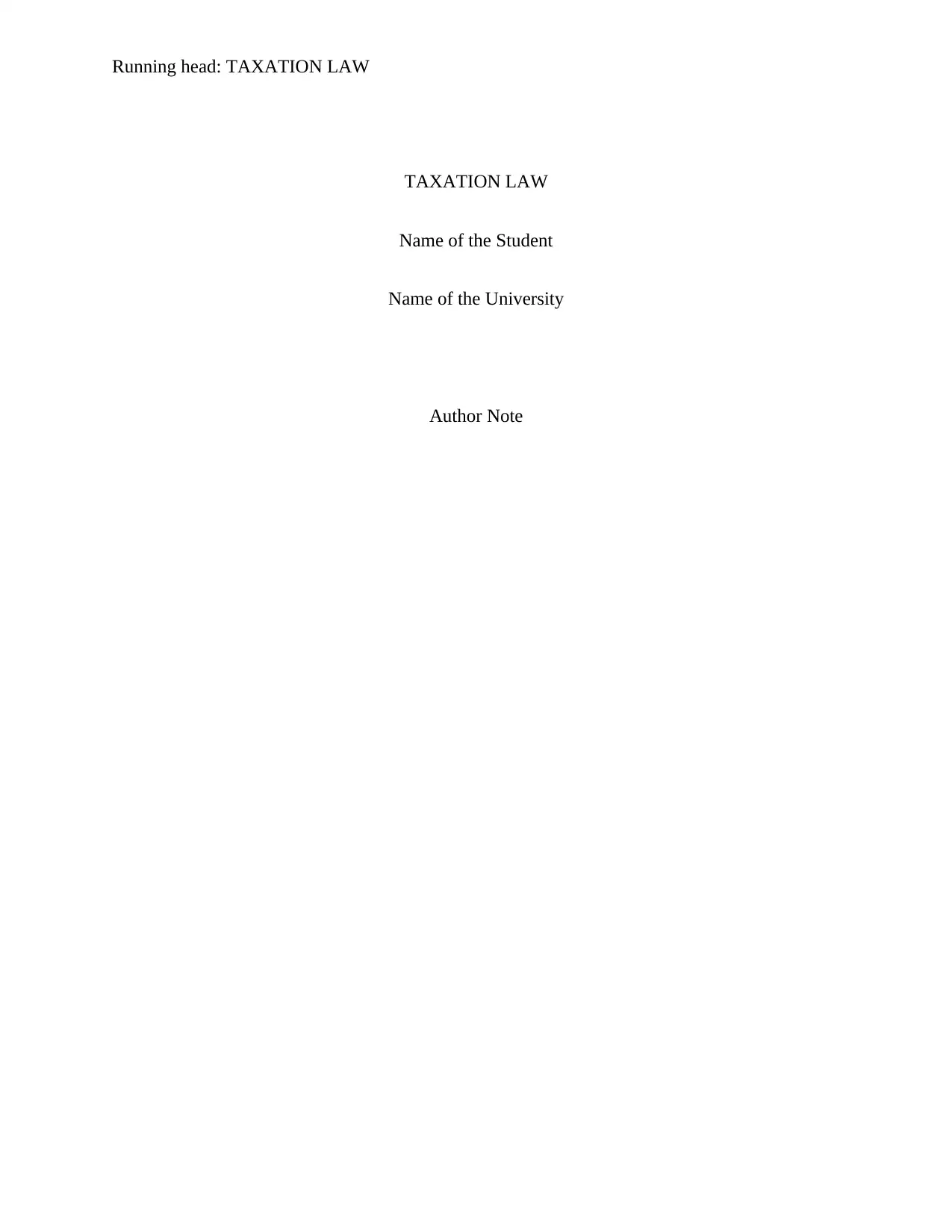
Running head: TAXATION LAW
TAXATION LAW
Name of the Student
Name of the University
Author Note
TAXATION LAW
Name of the Student
Name of the University
Author Note
Paraphrase This Document
Need a fresh take? Get an instant paraphrase of this document with our AI Paraphraser
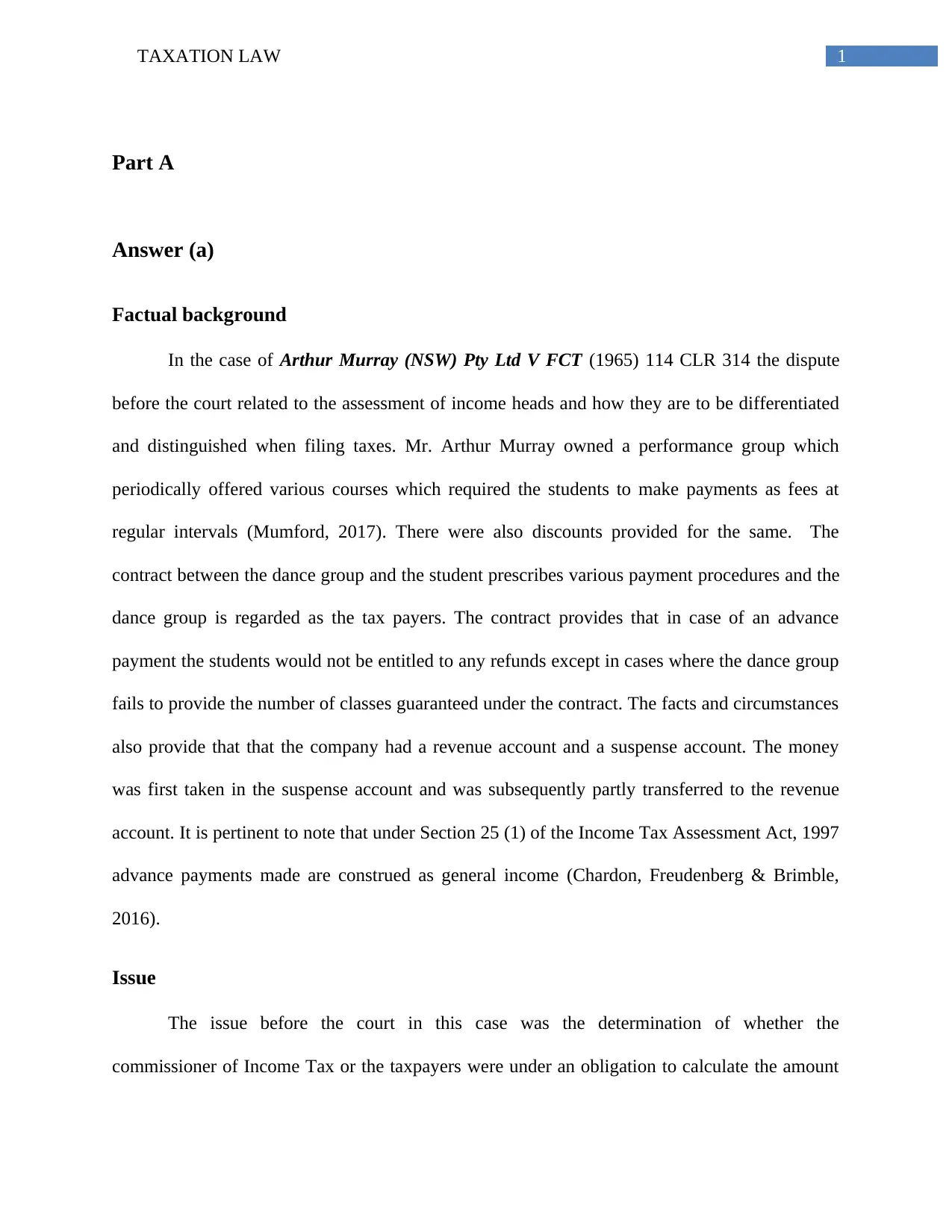
1TAXATION LAW
Part A
Answer (a)
Factual background
In the case of Arthur Murray (NSW) Pty Ltd V FCT (1965) 114 CLR 314 the dispute
before the court related to the assessment of income heads and how they are to be differentiated
and distinguished when filing taxes. Mr. Arthur Murray owned a performance group which
periodically offered various courses which required the students to make payments as fees at
regular intervals (Mumford, 2017). There were also discounts provided for the same. The
contract between the dance group and the student prescribes various payment procedures and the
dance group is regarded as the tax payers. The contract provides that in case of an advance
payment the students would not be entitled to any refunds except in cases where the dance group
fails to provide the number of classes guaranteed under the contract. The facts and circumstances
also provide that that the company had a revenue account and a suspense account. The money
was first taken in the suspense account and was subsequently partly transferred to the revenue
account. It is pertinent to note that under Section 25 (1) of the Income Tax Assessment Act, 1997
advance payments made are construed as general income (Chardon, Freudenberg & Brimble,
2016).
Issue
The issue before the court in this case was the determination of whether the
commissioner of Income Tax or the taxpayers were under an obligation to calculate the amount
Part A
Answer (a)
Factual background
In the case of Arthur Murray (NSW) Pty Ltd V FCT (1965) 114 CLR 314 the dispute
before the court related to the assessment of income heads and how they are to be differentiated
and distinguished when filing taxes. Mr. Arthur Murray owned a performance group which
periodically offered various courses which required the students to make payments as fees at
regular intervals (Mumford, 2017). There were also discounts provided for the same. The
contract between the dance group and the student prescribes various payment procedures and the
dance group is regarded as the tax payers. The contract provides that in case of an advance
payment the students would not be entitled to any refunds except in cases where the dance group
fails to provide the number of classes guaranteed under the contract. The facts and circumstances
also provide that that the company had a revenue account and a suspense account. The money
was first taken in the suspense account and was subsequently partly transferred to the revenue
account. It is pertinent to note that under Section 25 (1) of the Income Tax Assessment Act, 1997
advance payments made are construed as general income (Chardon, Freudenberg & Brimble,
2016).
Issue
The issue before the court in this case was the determination of whether the
commissioner of Income Tax or the taxpayers were under an obligation to calculate the amount
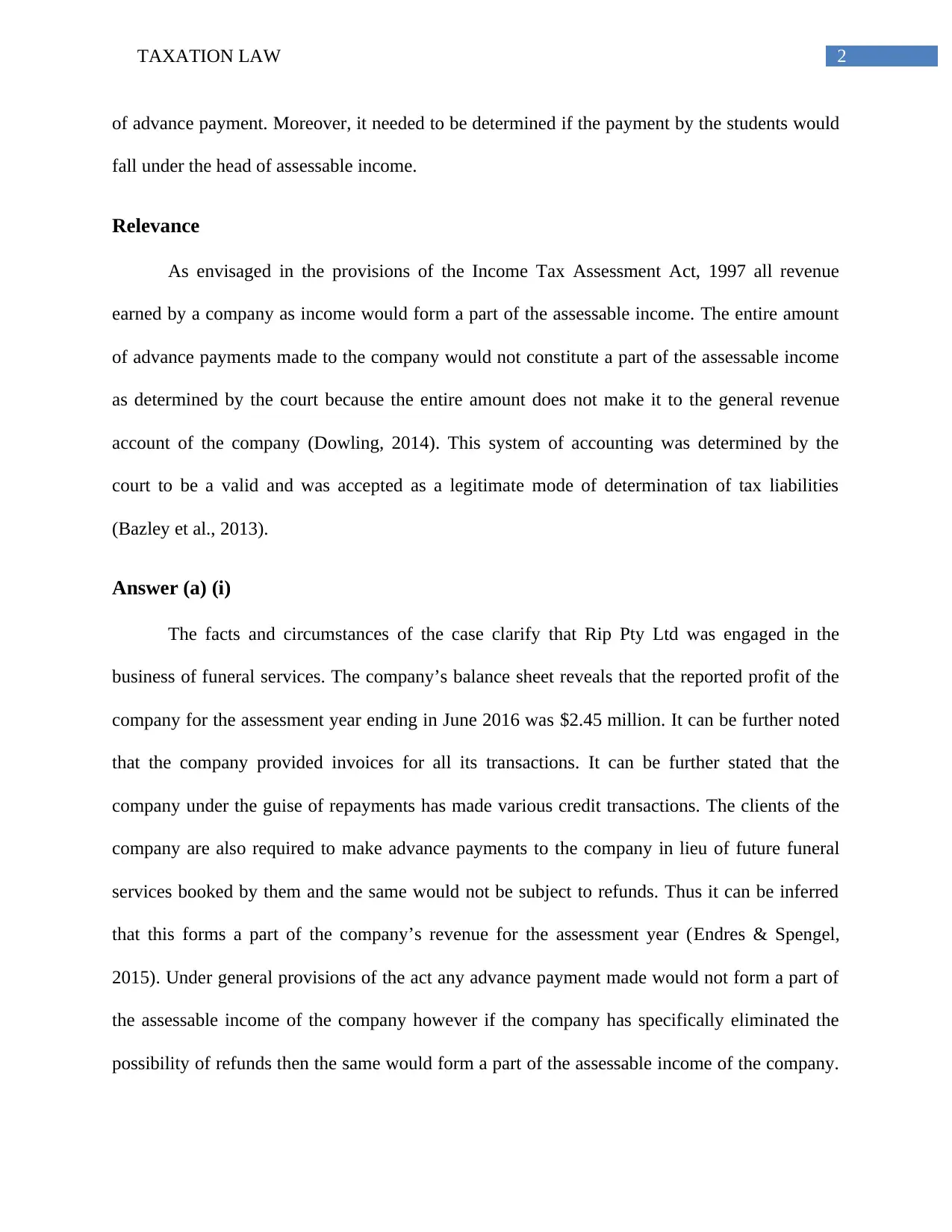
2TAXATION LAW
of advance payment. Moreover, it needed to be determined if the payment by the students would
fall under the head of assessable income.
Relevance
As envisaged in the provisions of the Income Tax Assessment Act, 1997 all revenue
earned by a company as income would form a part of the assessable income. The entire amount
of advance payments made to the company would not constitute a part of the assessable income
as determined by the court because the entire amount does not make it to the general revenue
account of the company (Dowling, 2014). This system of accounting was determined by the
court to be a valid and was accepted as a legitimate mode of determination of tax liabilities
(Bazley et al., 2013).
Answer (a) (i)
The facts and circumstances of the case clarify that Rip Pty Ltd was engaged in the
business of funeral services. The company’s balance sheet reveals that the reported profit of the
company for the assessment year ending in June 2016 was $2.45 million. It can be further noted
that the company provided invoices for all its transactions. It can be further stated that the
company under the guise of repayments has made various credit transactions. The clients of the
company are also required to make advance payments to the company in lieu of future funeral
services booked by them and the same would not be subject to refunds. Thus it can be inferred
that this forms a part of the company’s revenue for the assessment year (Endres & Spengel,
2015). Under general provisions of the act any advance payment made would not form a part of
the assessable income of the company however if the company has specifically eliminated the
possibility of refunds then the same would form a part of the assessable income of the company.
of advance payment. Moreover, it needed to be determined if the payment by the students would
fall under the head of assessable income.
Relevance
As envisaged in the provisions of the Income Tax Assessment Act, 1997 all revenue
earned by a company as income would form a part of the assessable income. The entire amount
of advance payments made to the company would not constitute a part of the assessable income
as determined by the court because the entire amount does not make it to the general revenue
account of the company (Dowling, 2014). This system of accounting was determined by the
court to be a valid and was accepted as a legitimate mode of determination of tax liabilities
(Bazley et al., 2013).
Answer (a) (i)
The facts and circumstances of the case clarify that Rip Pty Ltd was engaged in the
business of funeral services. The company’s balance sheet reveals that the reported profit of the
company for the assessment year ending in June 2016 was $2.45 million. It can be further noted
that the company provided invoices for all its transactions. It can be further stated that the
company under the guise of repayments has made various credit transactions. The clients of the
company are also required to make advance payments to the company in lieu of future funeral
services booked by them and the same would not be subject to refunds. Thus it can be inferred
that this forms a part of the company’s revenue for the assessment year (Endres & Spengel,
2015). Under general provisions of the act any advance payment made would not form a part of
the assessable income of the company however if the company has specifically eliminated the
possibility of refunds then the same would form a part of the assessable income of the company.
⊘ This is a preview!⊘
Do you want full access?
Subscribe today to unlock all pages.

Trusted by 1+ million students worldwide
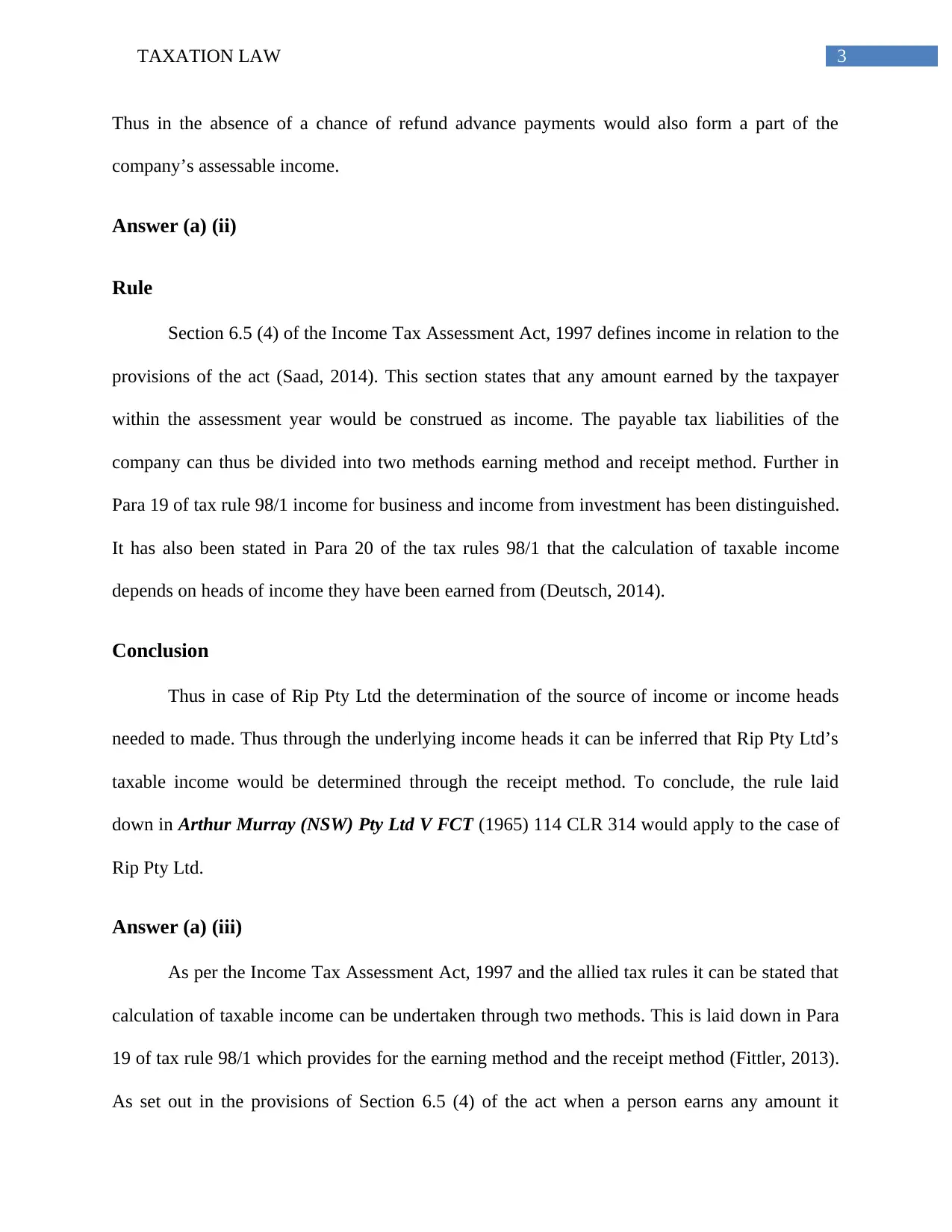
3TAXATION LAW
Thus in the absence of a chance of refund advance payments would also form a part of the
company’s assessable income.
Answer (a) (ii)
Rule
Section 6.5 (4) of the Income Tax Assessment Act, 1997 defines income in relation to the
provisions of the act (Saad, 2014). This section states that any amount earned by the taxpayer
within the assessment year would be construed as income. The payable tax liabilities of the
company can thus be divided into two methods earning method and receipt method. Further in
Para 19 of tax rule 98/1 income for business and income from investment has been distinguished.
It has also been stated in Para 20 of the tax rules 98/1 that the calculation of taxable income
depends on heads of income they have been earned from (Deutsch, 2014).
Conclusion
Thus in case of Rip Pty Ltd the determination of the source of income or income heads
needed to made. Thus through the underlying income heads it can be inferred that Rip Pty Ltd’s
taxable income would be determined through the receipt method. To conclude, the rule laid
down in Arthur Murray (NSW) Pty Ltd V FCT (1965) 114 CLR 314 would apply to the case of
Rip Pty Ltd.
Answer (a) (iii)
As per the Income Tax Assessment Act, 1997 and the allied tax rules it can be stated that
calculation of taxable income can be undertaken through two methods. This is laid down in Para
19 of tax rule 98/1 which provides for the earning method and the receipt method (Fittler, 2013).
As set out in the provisions of Section 6.5 (4) of the act when a person earns any amount it
Thus in the absence of a chance of refund advance payments would also form a part of the
company’s assessable income.
Answer (a) (ii)
Rule
Section 6.5 (4) of the Income Tax Assessment Act, 1997 defines income in relation to the
provisions of the act (Saad, 2014). This section states that any amount earned by the taxpayer
within the assessment year would be construed as income. The payable tax liabilities of the
company can thus be divided into two methods earning method and receipt method. Further in
Para 19 of tax rule 98/1 income for business and income from investment has been distinguished.
It has also been stated in Para 20 of the tax rules 98/1 that the calculation of taxable income
depends on heads of income they have been earned from (Deutsch, 2014).
Conclusion
Thus in case of Rip Pty Ltd the determination of the source of income or income heads
needed to made. Thus through the underlying income heads it can be inferred that Rip Pty Ltd’s
taxable income would be determined through the receipt method. To conclude, the rule laid
down in Arthur Murray (NSW) Pty Ltd V FCT (1965) 114 CLR 314 would apply to the case of
Rip Pty Ltd.
Answer (a) (iii)
As per the Income Tax Assessment Act, 1997 and the allied tax rules it can be stated that
calculation of taxable income can be undertaken through two methods. This is laid down in Para
19 of tax rule 98/1 which provides for the earning method and the receipt method (Fittler, 2013).
As set out in the provisions of Section 6.5 (4) of the act when a person earns any amount it
Paraphrase This Document
Need a fresh take? Get an instant paraphrase of this document with our AI Paraphraser
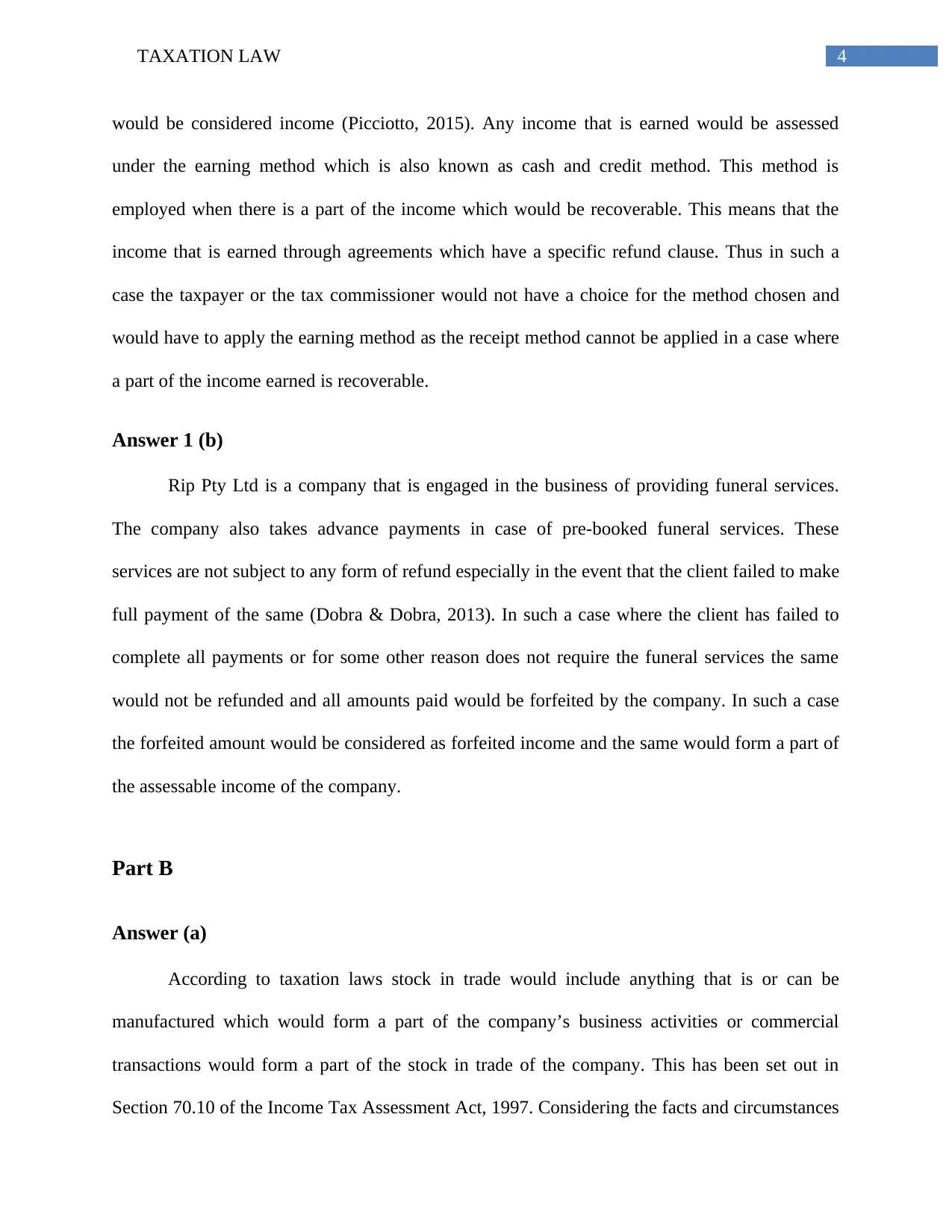
4TAXATION LAW
would be considered income (Picciotto, 2015). Any income that is earned would be assessed
under the earning method which is also known as cash and credit method. This method is
employed when there is a part of the income which would be recoverable. This means that the
income that is earned through agreements which have a specific refund clause. Thus in such a
case the taxpayer or the tax commissioner would not have a choice for the method chosen and
would have to apply the earning method as the receipt method cannot be applied in a case where
a part of the income earned is recoverable.
Answer 1 (b)
Rip Pty Ltd is a company that is engaged in the business of providing funeral services.
The company also takes advance payments in case of pre-booked funeral services. These
services are not subject to any form of refund especially in the event that the client failed to make
full payment of the same (Dobra & Dobra, 2013). In such a case where the client has failed to
complete all payments or for some other reason does not require the funeral services the same
would not be refunded and all amounts paid would be forfeited by the company. In such a case
the forfeited amount would be considered as forfeited income and the same would form a part of
the assessable income of the company.
Part B
Answer (a)
According to taxation laws stock in trade would include anything that is or can be
manufactured which would form a part of the company’s business activities or commercial
transactions would form a part of the stock in trade of the company. This has been set out in
Section 70.10 of the Income Tax Assessment Act, 1997. Considering the facts and circumstances
would be considered income (Picciotto, 2015). Any income that is earned would be assessed
under the earning method which is also known as cash and credit method. This method is
employed when there is a part of the income which would be recoverable. This means that the
income that is earned through agreements which have a specific refund clause. Thus in such a
case the taxpayer or the tax commissioner would not have a choice for the method chosen and
would have to apply the earning method as the receipt method cannot be applied in a case where
a part of the income earned is recoverable.
Answer 1 (b)
Rip Pty Ltd is a company that is engaged in the business of providing funeral services.
The company also takes advance payments in case of pre-booked funeral services. These
services are not subject to any form of refund especially in the event that the client failed to make
full payment of the same (Dobra & Dobra, 2013). In such a case where the client has failed to
complete all payments or for some other reason does not require the funeral services the same
would not be refunded and all amounts paid would be forfeited by the company. In such a case
the forfeited amount would be considered as forfeited income and the same would form a part of
the assessable income of the company.
Part B
Answer (a)
According to taxation laws stock in trade would include anything that is or can be
manufactured which would form a part of the company’s business activities or commercial
transactions would form a part of the stock in trade of the company. This has been set out in
Section 70.10 of the Income Tax Assessment Act, 1997. Considering the facts and circumstances
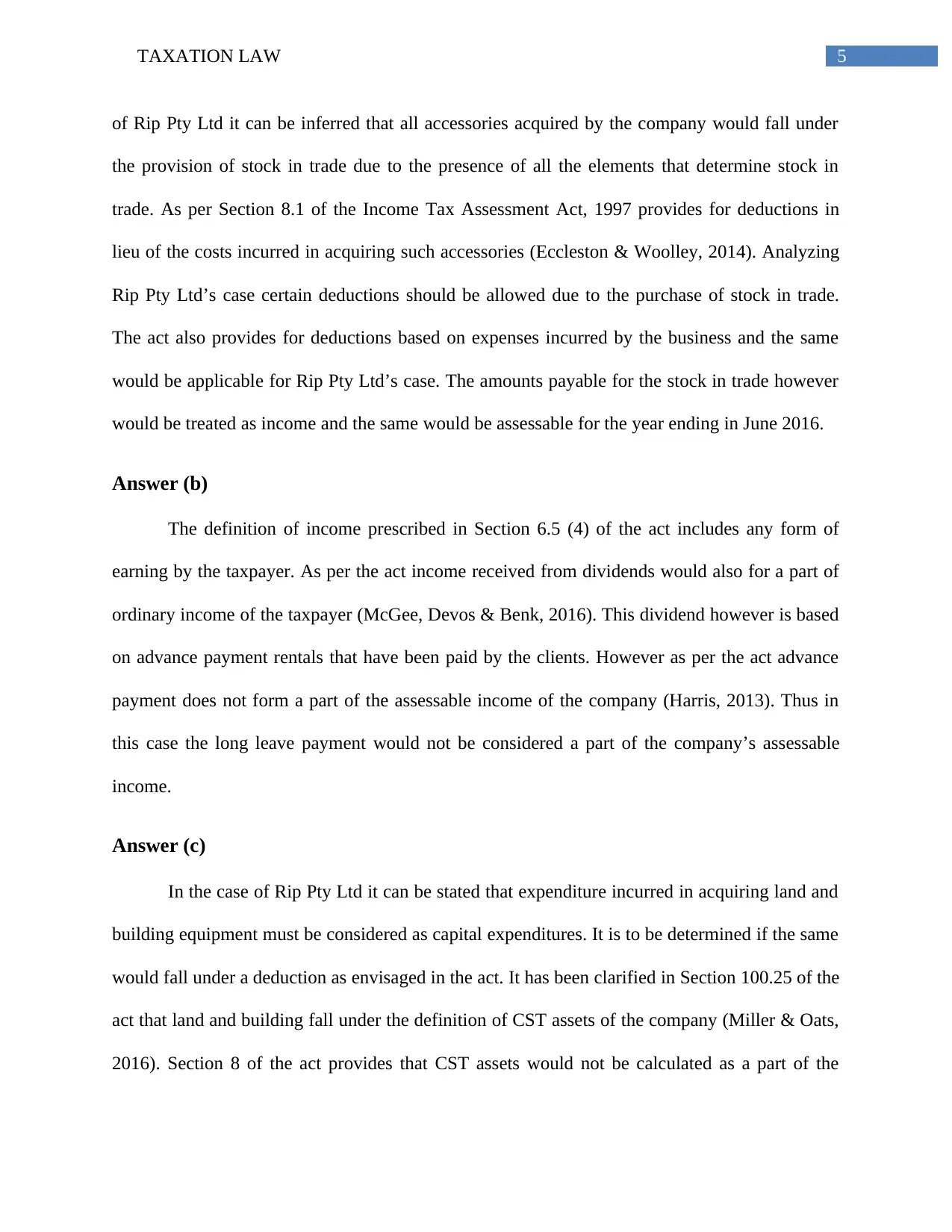
5TAXATION LAW
of Rip Pty Ltd it can be inferred that all accessories acquired by the company would fall under
the provision of stock in trade due to the presence of all the elements that determine stock in
trade. As per Section 8.1 of the Income Tax Assessment Act, 1997 provides for deductions in
lieu of the costs incurred in acquiring such accessories (Eccleston & Woolley, 2014). Analyzing
Rip Pty Ltd’s case certain deductions should be allowed due to the purchase of stock in trade.
The act also provides for deductions based on expenses incurred by the business and the same
would be applicable for Rip Pty Ltd’s case. The amounts payable for the stock in trade however
would be treated as income and the same would be assessable for the year ending in June 2016.
Answer (b)
The definition of income prescribed in Section 6.5 (4) of the act includes any form of
earning by the taxpayer. As per the act income received from dividends would also for a part of
ordinary income of the taxpayer (McGee, Devos & Benk, 2016). This dividend however is based
on advance payment rentals that have been paid by the clients. However as per the act advance
payment does not form a part of the assessable income of the company (Harris, 2013). Thus in
this case the long leave payment would not be considered a part of the company’s assessable
income.
Answer (c)
In the case of Rip Pty Ltd it can be stated that expenditure incurred in acquiring land and
building equipment must be considered as capital expenditures. It is to be determined if the same
would fall under a deduction as envisaged in the act. It has been clarified in Section 100.25 of the
act that land and building fall under the definition of CST assets of the company (Miller & Oats,
2016). Section 8 of the act provides that CST assets would not be calculated as a part of the
of Rip Pty Ltd it can be inferred that all accessories acquired by the company would fall under
the provision of stock in trade due to the presence of all the elements that determine stock in
trade. As per Section 8.1 of the Income Tax Assessment Act, 1997 provides for deductions in
lieu of the costs incurred in acquiring such accessories (Eccleston & Woolley, 2014). Analyzing
Rip Pty Ltd’s case certain deductions should be allowed due to the purchase of stock in trade.
The act also provides for deductions based on expenses incurred by the business and the same
would be applicable for Rip Pty Ltd’s case. The amounts payable for the stock in trade however
would be treated as income and the same would be assessable for the year ending in June 2016.
Answer (b)
The definition of income prescribed in Section 6.5 (4) of the act includes any form of
earning by the taxpayer. As per the act income received from dividends would also for a part of
ordinary income of the taxpayer (McGee, Devos & Benk, 2016). This dividend however is based
on advance payment rentals that have been paid by the clients. However as per the act advance
payment does not form a part of the assessable income of the company (Harris, 2013). Thus in
this case the long leave payment would not be considered a part of the company’s assessable
income.
Answer (c)
In the case of Rip Pty Ltd it can be stated that expenditure incurred in acquiring land and
building equipment must be considered as capital expenditures. It is to be determined if the same
would fall under a deduction as envisaged in the act. It has been clarified in Section 100.25 of the
act that land and building fall under the definition of CST assets of the company (Miller & Oats,
2016). Section 8 of the act provides that CST assets would not be calculated as a part of the
⊘ This is a preview!⊘
Do you want full access?
Subscribe today to unlock all pages.

Trusted by 1+ million students worldwide
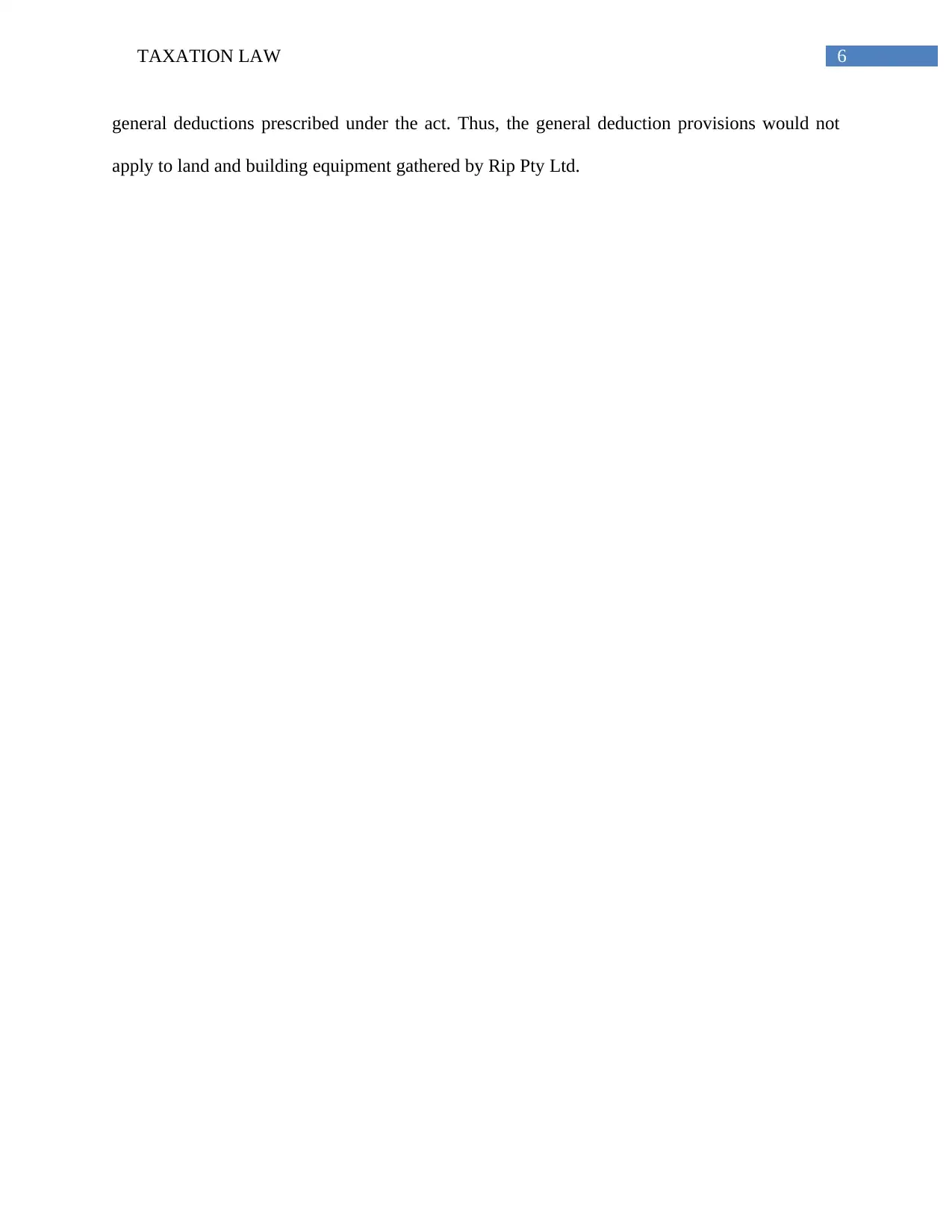
6TAXATION LAW
general deductions prescribed under the act. Thus, the general deduction provisions would not
apply to land and building equipment gathered by Rip Pty Ltd.
general deductions prescribed under the act. Thus, the general deduction provisions would not
apply to land and building equipment gathered by Rip Pty Ltd.
Paraphrase This Document
Need a fresh take? Get an instant paraphrase of this document with our AI Paraphraser
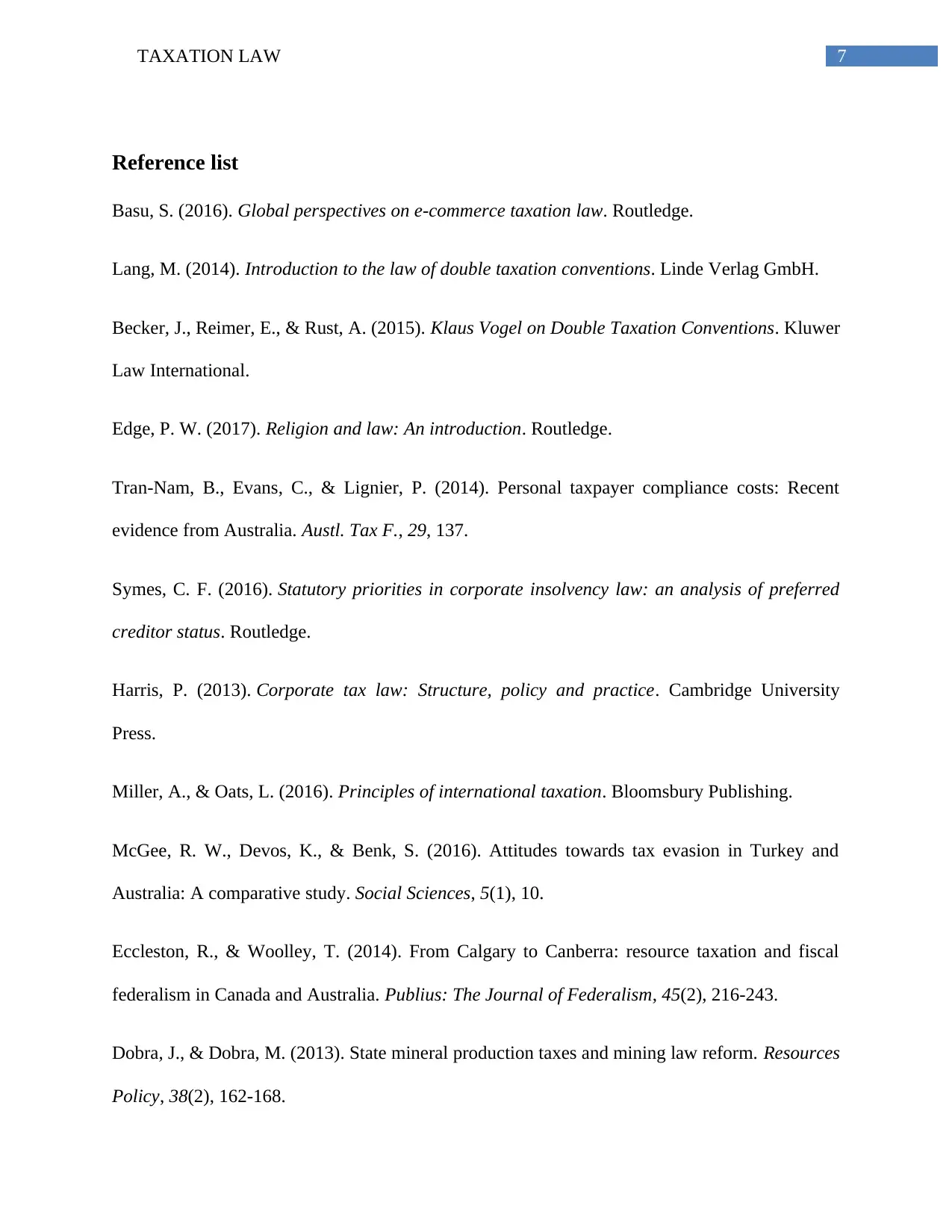
7TAXATION LAW
Reference list
Basu, S. (2016). Global perspectives on e-commerce taxation law. Routledge.
Lang, M. (2014). Introduction to the law of double taxation conventions. Linde Verlag GmbH.
Becker, J., Reimer, E., & Rust, A. (2015). Klaus Vogel on Double Taxation Conventions. Kluwer
Law International.
Edge, P. W. (2017). Religion and law: An introduction. Routledge.
Tran-Nam, B., Evans, C., & Lignier, P. (2014). Personal taxpayer compliance costs: Recent
evidence from Australia. Austl. Tax F., 29, 137.
Symes, C. F. (2016). Statutory priorities in corporate insolvency law: an analysis of preferred
creditor status. Routledge.
Harris, P. (2013). Corporate tax law: Structure, policy and practice. Cambridge University
Press.
Miller, A., & Oats, L. (2016). Principles of international taxation. Bloomsbury Publishing.
McGee, R. W., Devos, K., & Benk, S. (2016). Attitudes towards tax evasion in Turkey and
Australia: A comparative study. Social Sciences, 5(1), 10.
Eccleston, R., & Woolley, T. (2014). From Calgary to Canberra: resource taxation and fiscal
federalism in Canada and Australia. Publius: The Journal of Federalism, 45(2), 216-243.
Dobra, J., & Dobra, M. (2013). State mineral production taxes and mining law reform. Resources
Policy, 38(2), 162-168.
Reference list
Basu, S. (2016). Global perspectives on e-commerce taxation law. Routledge.
Lang, M. (2014). Introduction to the law of double taxation conventions. Linde Verlag GmbH.
Becker, J., Reimer, E., & Rust, A. (2015). Klaus Vogel on Double Taxation Conventions. Kluwer
Law International.
Edge, P. W. (2017). Religion and law: An introduction. Routledge.
Tran-Nam, B., Evans, C., & Lignier, P. (2014). Personal taxpayer compliance costs: Recent
evidence from Australia. Austl. Tax F., 29, 137.
Symes, C. F. (2016). Statutory priorities in corporate insolvency law: an analysis of preferred
creditor status. Routledge.
Harris, P. (2013). Corporate tax law: Structure, policy and practice. Cambridge University
Press.
Miller, A., & Oats, L. (2016). Principles of international taxation. Bloomsbury Publishing.
McGee, R. W., Devos, K., & Benk, S. (2016). Attitudes towards tax evasion in Turkey and
Australia: A comparative study. Social Sciences, 5(1), 10.
Eccleston, R., & Woolley, T. (2014). From Calgary to Canberra: resource taxation and fiscal
federalism in Canada and Australia. Publius: The Journal of Federalism, 45(2), 216-243.
Dobra, J., & Dobra, M. (2013). State mineral production taxes and mining law reform. Resources
Policy, 38(2), 162-168.
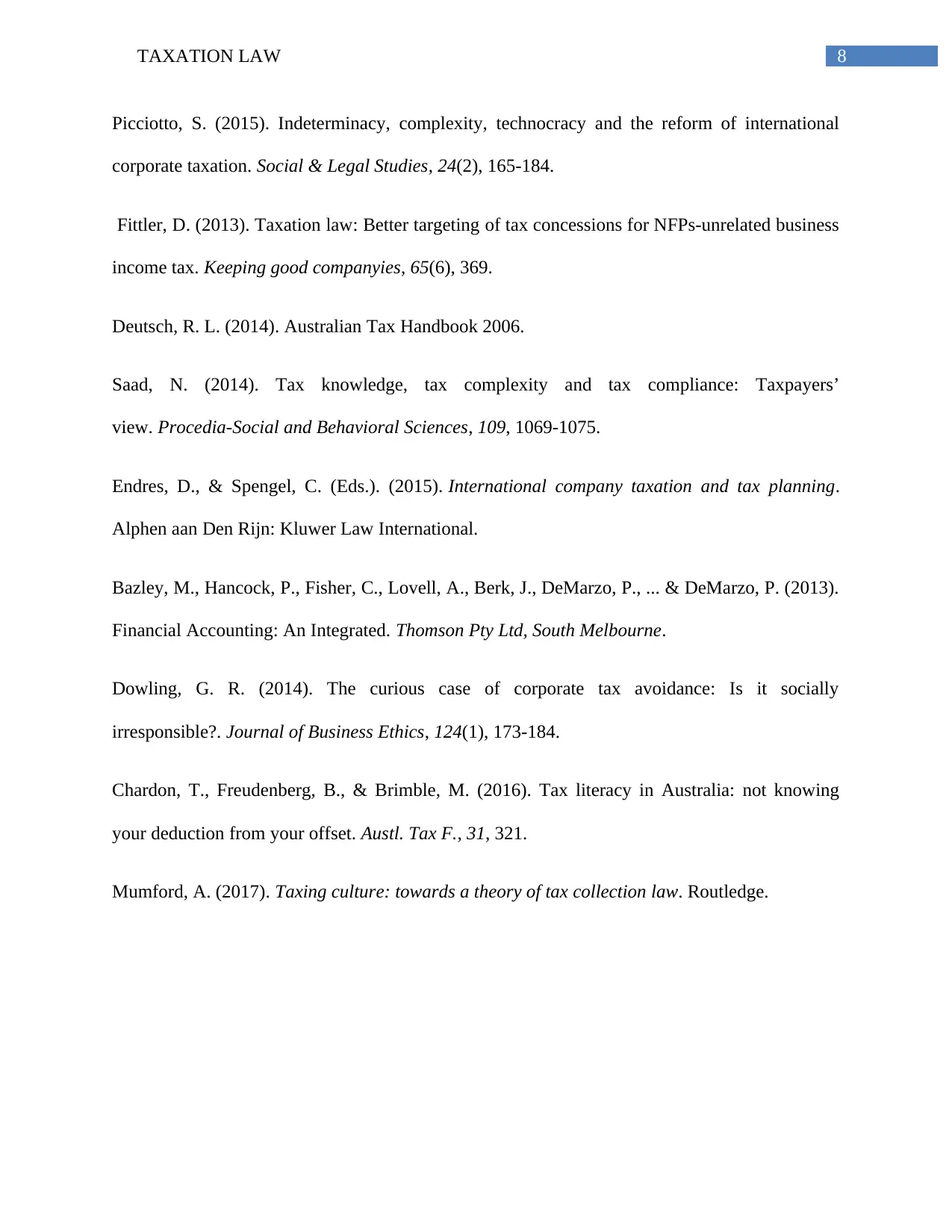
8TAXATION LAW
Picciotto, S. (2015). Indeterminacy, complexity, technocracy and the reform of international
corporate taxation. Social & Legal Studies, 24(2), 165-184.
Fittler, D. (2013). Taxation law: Better targeting of tax concessions for NFPs-unrelated business
income tax. Keeping good companyies, 65(6), 369.
Deutsch, R. L. (2014). Australian Tax Handbook 2006.
Saad, N. (2014). Tax knowledge, tax complexity and tax compliance: Taxpayers’
view. Procedia-Social and Behavioral Sciences, 109, 1069-1075.
Endres, D., & Spengel, C. (Eds.). (2015). International company taxation and tax planning.
Alphen aan Den Rijn: Kluwer Law International.
Bazley, M., Hancock, P., Fisher, C., Lovell, A., Berk, J., DeMarzo, P., ... & DeMarzo, P. (2013).
Financial Accounting: An Integrated. Thomson Pty Ltd, South Melbourne.
Dowling, G. R. (2014). The curious case of corporate tax avoidance: Is it socially
irresponsible?. Journal of Business Ethics, 124(1), 173-184.
Chardon, T., Freudenberg, B., & Brimble, M. (2016). Tax literacy in Australia: not knowing
your deduction from your offset. Austl. Tax F., 31, 321.
Mumford, A. (2017). Taxing culture: towards a theory of tax collection law. Routledge.
Picciotto, S. (2015). Indeterminacy, complexity, technocracy and the reform of international
corporate taxation. Social & Legal Studies, 24(2), 165-184.
Fittler, D. (2013). Taxation law: Better targeting of tax concessions for NFPs-unrelated business
income tax. Keeping good companyies, 65(6), 369.
Deutsch, R. L. (2014). Australian Tax Handbook 2006.
Saad, N. (2014). Tax knowledge, tax complexity and tax compliance: Taxpayers’
view. Procedia-Social and Behavioral Sciences, 109, 1069-1075.
Endres, D., & Spengel, C. (Eds.). (2015). International company taxation and tax planning.
Alphen aan Den Rijn: Kluwer Law International.
Bazley, M., Hancock, P., Fisher, C., Lovell, A., Berk, J., DeMarzo, P., ... & DeMarzo, P. (2013).
Financial Accounting: An Integrated. Thomson Pty Ltd, South Melbourne.
Dowling, G. R. (2014). The curious case of corporate tax avoidance: Is it socially
irresponsible?. Journal of Business Ethics, 124(1), 173-184.
Chardon, T., Freudenberg, B., & Brimble, M. (2016). Tax literacy in Australia: not knowing
your deduction from your offset. Austl. Tax F., 31, 321.
Mumford, A. (2017). Taxing culture: towards a theory of tax collection law. Routledge.
⊘ This is a preview!⊘
Do you want full access?
Subscribe today to unlock all pages.

Trusted by 1+ million students worldwide
1 out of 9
Related Documents
Your All-in-One AI-Powered Toolkit for Academic Success.
+13062052269
info@desklib.com
Available 24*7 on WhatsApp / Email
![[object Object]](/_next/static/media/star-bottom.7253800d.svg)
Unlock your academic potential
Copyright © 2020–2025 A2Z Services. All Rights Reserved. Developed and managed by ZUCOL.




